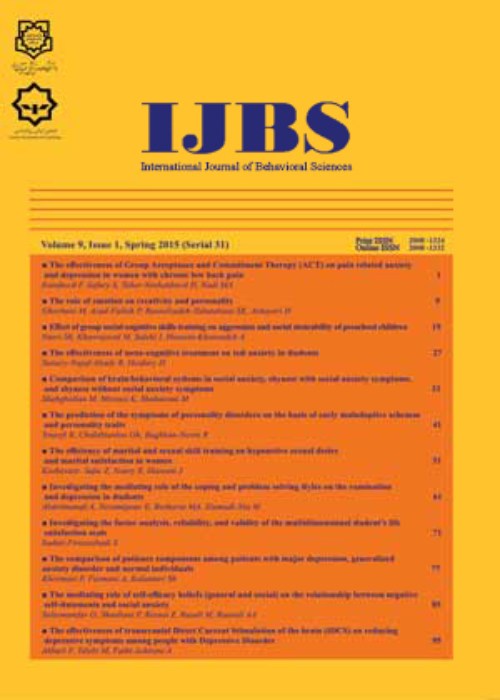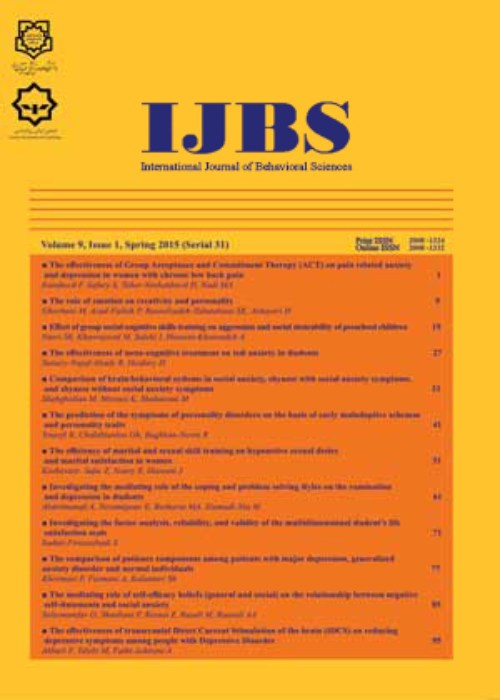فهرست مطالب

International Journal of Behavioral Sciences
Volume:17 Issue: 1, Spring 2023
- تاریخ انتشار: 1402/02/11
- تعداد عناوین: 8
-
-
Pages 1-7IntroductionThe parent-adolescent communication is an essential element in transitioning the adolescent to adulthood. This study aimed to illustrate a new ongoing parent-adolescent structure that is happening in Iran, and examines changes in family patterns.MethodA qualitative thematic analysis was performed on data collected from 24 interviews with adolescents, and their parents in 2021. The samples were recruited through purposeful sampling. This study was conducted within nine months. The interviewees were four boys and eight girls (M=17) and one of their parents, whether their mother or father. Semi-structured interviews were conducted. The method of data analysis was the Colaizzi descriptive method.ResultsThematic analysis revealed a new interaction pattern that did not exist in the previous generation. There were four main themes in parental patterns namely; adaptive pattern, influenced-pattern, democratic pattern, expertise-centric pattern, and also nine sub-themes. In adolescence, the only pattern was the democratic pattern with four sub-themes, which leads to new expectations from adolescents, like having an equal power hierarchy.ConclusionConversely, to what has been thought, parents have a significant and distinct role in parent-adolescent interaction changes. A large part of this was due to their bad memories or deprivation of good parenting when they were a child. These results can be used for planning macro-political, and socio-economic policies concerning future parent-adolescent interaction trends.Keywords: Adolescent, Parents, Interaction, Iranian Adolescent, Qualitative study
-
Pages 8-15IntroductionCouple satisfaction is a major and complicated aspect of marital life inside a family. Various factors are involved in it and affect it. The goal of the present study was to investigate the mediating role of boredom and mentalization in the relationship between attachment and marital satisfaction of women and men in the city of Bandar Abbas.MethodThe study method falls under descriptive and correlative research. The statistical population of the study consisted of all married people in the city of Bandar Abbas in 2021-2022, out of whom 350 people were selected via the convenience sampling method. To gather data, Pines’ Marital Boredom Scale (1996), Fonagy’s Reflective Functioning Questionnaire (2016), Attachment Questionnaire, and Olson’s Marital Satisfaction Scale (1994). To evaluate the hypothetical model and indirect effects, the maximum likelihood estimation and Bootstrap test were used. To analyze data, SPSS (version 23) and LISREL (Version 8.8) Software were used.ResultsSecure and avoidant attachment styles with the standard coefficients of -0.37 and -0.24 were found to affect mentalization and marital boredom; mentalization and marital boredom with the standard coefficients of -0.17 and -0.14 affected marital satisfaction. In addition, secure and insecure attachment styles with the standard coefficients of 0.20 and -0.47 affected marital satisfaction (all effects were significant at p˂0.001).ConclusionAccording to the findings of the present study, it can be stated that couples’ attachment (secure or avoidant) styles and other variables affecting attachment, i.e., mentalization and boredom can affect couples’ marital satisfaction.Keywords: marital satisfaction, Mentalization, marital boredom, attachment style
-
Pages 16-23IntroductionThis study aimed to investigate the mediating role of emotion regulation difficulty in the relationship between traumatic childhood experiences and self-criticism in adulthood.MethodThe design of the present study was descriptive-correlational and structural equation modeling. The statistical population of this study included Iranian adults who lived in Mashhad in 2021. Among them, 331 individuals were selected as the research sample through the convenient sampling method. Data were collected online using the Levels of Self Criticism Scale by Thompson and Zarov in 2004 (LOCS), the Childhood Trauma Questionnaire by Bernstein et al. in 2003 (CTQ), and the Gratz and Roemer Difficulties in Emotion Regulation Scale by Gratz and Roemer in 2004 (DERS). Data analysis was performed with the Pearson correlation method and structural equation.ResultsFindings showed that there was a significant correlation (P <0.01) between traumatic childhood experiences and emotion regulation difficulty with self-criticism. Also, the results of structural equation modeling showed that the model of the present study had a good fit and the mediating role of emotion regulation difficulty in the relationship between traumatic childhood experiences and self-criticism (χ2/df≤3 and significance level of 0.001) was significant.ConclusionAccording to the findings of this study, traumatic childhood experiences can predict and influence self-criticism by interacting with the emotion regulation difficulty.Keywords: Traumatic Childhood Experiences, Emotion regulation difficulty, self-criticism
-
Pages 24-31IntroductionAdjustment is defined as a process by which a person tries to cope with life challenges using different techniques and strategies, and by this means balances his/her different needs with environmental obstacles. The present research was conducted to determine the effectiveness of the Unified Protocols for Trans-diagnostic Treatment on adjustment, in bilingual junior high school students. The Unified Protocols for Trans-diagnostic Treatment of Emotional Disorders in Adolescents was used for this purpose which involved parents and students in the intervention.MethodThe statistical population of this study included bilingual students studying in the secondary section of Tehran International School in the academic year of 2021-2022. A Sample of 30 students of the school was selected in purposive method, and then they were randomly divided into two groups of 15 students (experimental and control groups). The research method was semi-experimental with a pre-test, post-test, and follow-up test design, which was implemented for both experimental and control groups. Between the pre-test and post-test, only the experimental group received family-centered psycho-education based on emotion regulation(15 two-hour sessions for students and four one-hour sessions for parents). The Adjustment Inventory for School Students by Sinha and Singh (1993) was used to collect data. The collected data was analyzed using a mixed variance analysis with repeated measures.ResultThe findings showed that the scores of adjustment of the students in the two groups had a significant difference in post-test and follow-up test compared to the pre-test (p < 0.05).ConclusionAccording to findings, family-centered psycho-education based on emotion regulation has been proven to be effective in increasing students' adjustment.Keywords: emotional regulation, Adjustment, adolescence, mental health
-
Pages 32-37IntroductionPeople with Borderline Personality Disorder (BPD) experience extreme mood swings, unstable relationships, and difficulty controlling emotions. The present study investigated the comparison of emotion regulation, mindfulness, and self-compassion with healthy individuals.MethodThe present study was conducted by using a causal-comparative research design. A 149 convenience sample of the adolescent general population was recruited in the healthy group with no known psychiatric disorders and BPD via psychiatrists and clinical psychologists by utilizing snowball sampling in the year 2021-2022 in Tehran. Participants were recruited with age, gender, and education matched healthy control. The research tools included the Difficulties in Emotion Regulation Scale (DERS), the Five Facet Mindfulness Questionnaire (FFMQ), and the Self-Compassion Scale (SCS). A MANOVA and an ANOVA test were performed to analyze the data using SPSS version 25 with a two-tailed 5% level of significance.ResultsThe findings showed that the mean scores of emotion regulation (34.44±5.86), mindfulness (96.47±14.79), and self-compassion (71.30±9.08) were lower in the group with borderline personality disorder compared to emotion regulation (48.54±7.33), mindfulness (136.74±13.41), and self-compassion (91.50±10.81) of the healthy group. In this study, a p-value <0.05 was considered statistically significant.ConclusionBPD patients reported poor emotion regulation, mindfulness, and compassion compared to a healthy control group. To these results, we suggest that teaching emotion regulation skills, mindfulness, and self-compassion to BPD patients can be crucial in the treatment of BPD.Keywords: emotion regulation, Mindfulness, self-compassion, borderline personality disorder, healthy, adolescents
-
Pages 38-45IntroductionBreast cancer is one of the diseases which is mostly affected by negative emotions. However, the context factors that leads to lack of positive valence in these patients is not clear. The current study aimed to identify the context factors in the lack of positive valence system in women suffering from breast cancer.MethodResearch method was qualitative grounded theory and data was obtained from in-depth interviews with patients at the Motamed Jihad University Cancer Research Institute during 2022. Participants were voluntarily and purposefully selected and sampling continued until data saturation. At the end, 10 individuals participated. Data were coded in three levels according to the Strauss and Corbin method.ResultsIn relation to the positive valence system, we extracted three theoretical, nine axial and 24 open codes. The theoretical codes contained reward response (with axial codes of reward prediction, initial response to reward and reward saturation), reward learning (with axial codes of prediction error and reward habit) and reward valuation (with the axial codes of uncertainty of risk, delay in reward valuation, frustrated non-reward and attempt to value rewards). Theoretical, axial and open codes were evaluated by experts to obtain internal and structural validity as well as conceptual framework model and therapy protocol that were designed by extracted codes.ConclusionThe possibility of decreasing or increasing the incidence of cancer depends on the presence or absence of the positive valence system. The suggested therapy protocol represented that the positive valence factors enhancement might limit the possibility of breast cancer.Keywords: breast cancer, Positive Valence System, Research Domain Criteria, Therapy Protocol
-
Pages 46-52IntroductionThe present study aimed to investigate the prevalence rates of depression, anxiety, and stress in residents of Mashhad in the early phases of COVID-19. Moreover, the current study investigated the associations of attentional control and responses related to the COVID-19 with depression, anxiety, and stress.MethodThis research was a cross-sectional correlational study that was conducted on 336 residents of Mashhad in 2020. The tools used in this study were researcher-made questionnaire, namely the COVID-19 related Behaviors scale (CB-19), the Depression Anxiety Stress Scale-21 (DASS-21), and the Attentional Control Scale (ACS). Data were analyzed by SPSS (version 22.0) and logistic regression analyses. A P<0.05 was considered statistically significant.ResultsThe psychometric analyses showed a good model fit for the CB-19 with two factors, including health behavior and psychological behavior subscales. A prevalence rate of 41.37%, 31.85%, and 30.36% was observed for depression, anxiety, and stress, respectively. In the regression analysis, poor focusing, and high levels of psychological responses related to the COVID-19 were risk factors of depression, anxiety, and stress (p<0.001).ConclusionAccording to the findings of the present study it can be stated that high levels of psychological responses and poor focusing can predict depression, anxiety and stress during COVID-19.Keywords: mental health, depression, anxiety, Stress, COVID-19
-
Pages 53-57IntroductionThis study investigated the mediating role of coping strategies in relation to self-care behaviors with early maladaptive schemas in people with type 2 diabetes.MethodThis descriptive, correlational research was conducted on patients referring to diabetes clinics in Tehran, 2021. In this study, 200 patients with type 2 diabetes were selected through convenience sampling. Research data were collected using Miller's health attitude scale (1982), Young's schema questionnaire (1995) and the coping strategies questionnaire of Lazarus and Folkman (1980). Data analyze was done using SPSS version 25 and Smart-PLS version 3 was used to fit the model.ResultsThe results showed that early maladaptive schemas have a direct and significant linear relationship with self-care behaviors (r = -0.630). Also, early maladaptive schemas have an indirect and significant linear relationship with self-care behaviors with the mediating role of coping strategies. The research model had a good fit and it can be said that 36% of self-care behaviors caused by diabetes are explained by coping strategies and early maladaptive schemas.ConclusionIn order to improve the level of self-care behaviors of people with type 2 diabetes, attention should be paid to the early maladaptive schemas and coping strategies.Keywords: Self-Care, Behavior, coping strategies, schema, Type 2 diabetes


